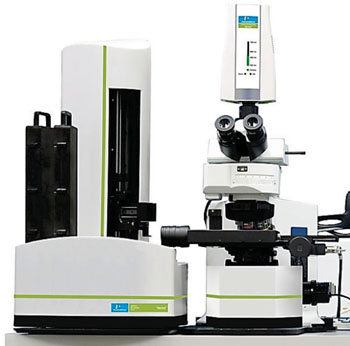Collagen Changes Linked to Poor Pancreatic Cancer Prognosis
By LabMedica International staff writers
Posted on 04 Nov 2016
Risk factors for pancreatic ductal adenocarcinoma (PDAC) progression after surgery are unclear, and additional prognostic factors are needed to inform treatment regimens and therapeutic targets.Posted on 04 Nov 2016
PDAC is characterized by advanced sclerosis of the extracellular matrix, and interactions between cancer cells, fibrillar collagen, and other stromal components play an integral role in progression. Changes in stromal collagen alignment have been shown to modulate cancer cell behavior and have important clinical value in other cancer types.

Image: The Vectra automated quantitative pathology imaging system (Photo courtesy of Perkin Elmer).
Scientist at the University of Wisconsin-Madison (Madison, WI, USA) examined surgical tissues from 114 pancreatic cancer patients and identified a particular rearrangement of collagen fibers surrounding the tumor as a "biomarker" of early death. A human PDAC tissue microarray (TMA) resource available at the University of Wisconsin Carbone Cancer Center was retrospectively studied. All source tissue for the TMA was from archival, formalin fixed paraffin embedded (FFPE) blocks that were created for the purpose of routine diagnostic examination.
The TMA was serially sectioned at 5 µm thickness, mounted on charged slides, and deparaffinized. The first section was stained using standard hematoxylin and eosin (H&E). The second section was co-stained for E-cadherin and vimentin immunohistofluorescence. Immunohistochemistry (IHC) was performed using an automated BenchMark ULTRA IHC/ISH staining platform. H&E and IHC slides were digitalized at ×20 using an Aperio CS2 Digital Pathology Scanner. The immunohistofluorescence slides were imaged on a Vectra 2.0 multispectral slide imaging system.
The pathology-confirmed tissues from 114 PDAC patients that underwent curative-intent surgery were retrospectively imaged with Second Harmonic Generation (SHG) microscopy, quantified with fiber segmentation algorithms, and correlated to patient survival. The same tissue regions were analyzed for epithelial-to-mesenchymal (EMT), α-SMA, and syndecan-1 using complimentary immunohistostaining and visualization techniques. Significant inter-tumoral variation in collagen alignment was found, and notably high collagen alignment was observed in 12% of the patient cohort. Stratification of patients according to collagen alignment revealed that high alignment is an independent negative factor following PDAC resection.
Sharon M. Weber, MD, FACS, a professor of surgery and a co-author on the study, said, “Prognosis, was our focus in this paper. Can we identify some signature in the pattern of collagen that will help us understand which patients are going to do well and which are not? Might collagen patterns also help us sort out which patients should undergo surgery? The patterns of collagen in cancer might also be used to ascertain the effectiveness of chemotherapy or radiation so that we can utilize those toxic treatments in those patients who will benefit most. It would be amazing if we could use these differences in collagen patterns to help discover new therapeutic targets for this devastating disease.” The study was published on October 20, 2016, in the journal Oncotarget.
Related Links:
University of Wisconsin-Madison














